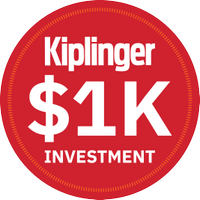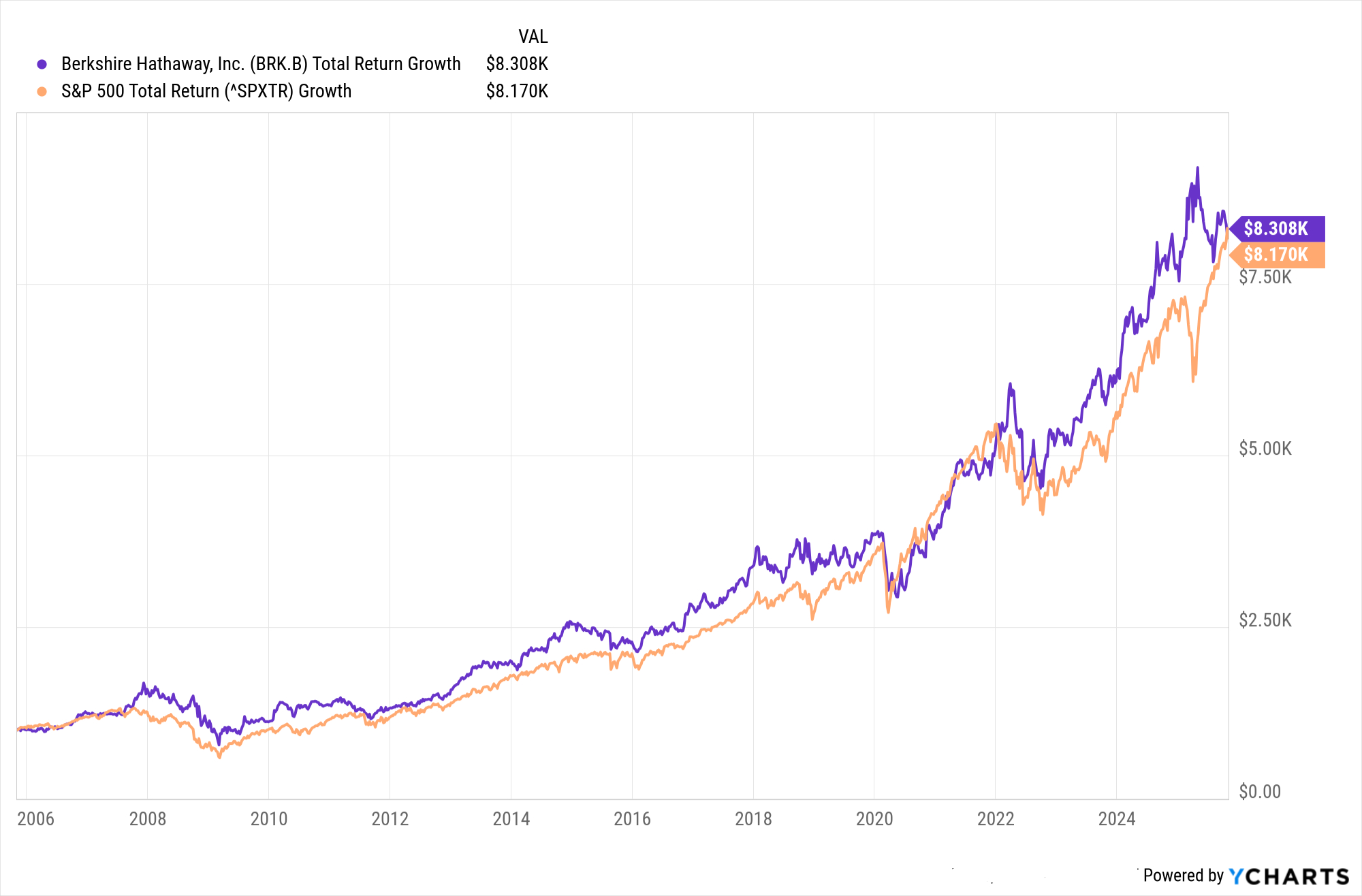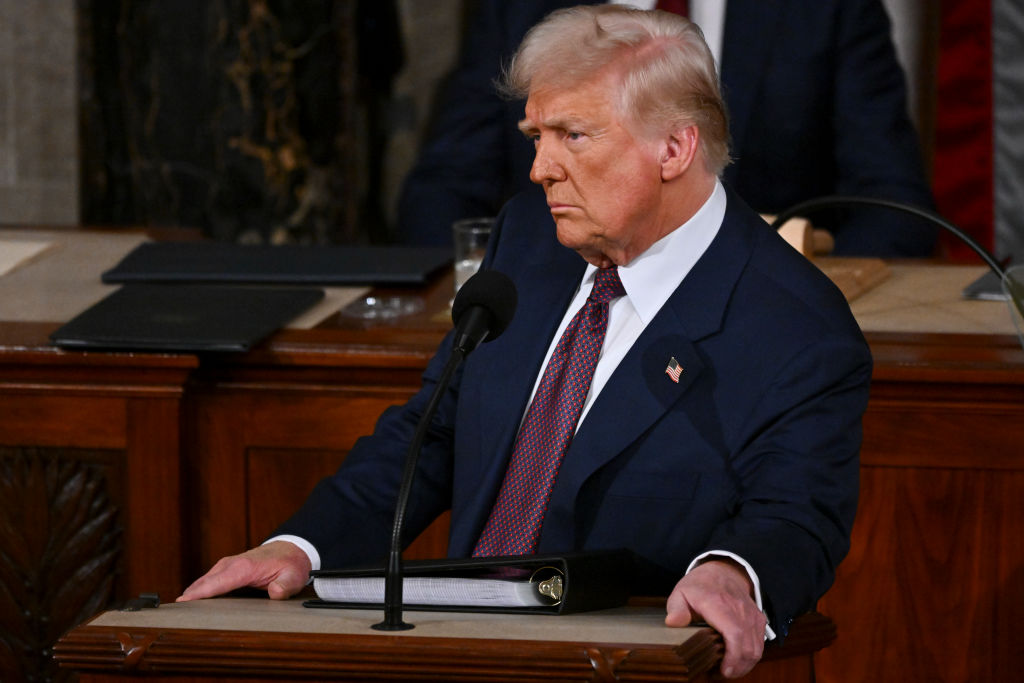If You'd Put $1,000 Into Berkshire Hathaway Stock 20 Years Ago, Here's What You'd Have Today
Berkshire Hathaway is a long-time market beater, but the easy money in BRK.B has already been made.



Berkshire Hathaway (BRK.B) is in a class by itself when it comes to really long-term outperformance. It's not for nothing that Warren Buffett, who will retire as CEO at the end of 2025, is known as the greatest long-term investor of all time.
BRK.B stock has been a market beater over the past 20 years, too, but all the millionaires Berkshire minted had skin in the game long before the turn of the century.
That's how compounding and the law of large numbers work.
From just $107.88 $24.99 for Kiplinger Personal Finance
Become a smarter, better informed investor. Subscribe from just $107.88 $24.99, plus get up to 4 Special Issues

Sign up for Kiplinger’s Free Newsletters
Profit and prosper with the best of expert advice on investing, taxes, retirement, personal finance and more - straight to your e-mail.
Profit and prosper with the best of expert advice - straight to your e-mail.
But first, a quick recap of Berkshire Hathaway's history. The company was a struggling textile firm when Buffett took control in 1965. Over the ensuing years, Buffett converted it into a holding company, or a company that buys other companies.
Buffett's first target was an insurance company, and the insurance business continues to be at the core of Berkshire's operations today.
Insurance was especially attractive to Buffett because of float, or the money insurance companies hold between collecting premiums and paying out claims. Thanks to the float from Berkshire's insurance companies, Buffett had ample sources of capital to buy up or invest in other enterprises.
Today, Berkshire Hathaway comprises more than 60 wholly owned subsidiaries, including BNSF Railway, Geico insurance, industrial titan Precision Castparts and fast food chain Dairy Queen.
Meanwhile, the Berkshire Hathaway equity portfolio, with a market value of about $250 billion, includes major stakes in Apple (AAPL), Bank of America (BAC) and American Express (AXP), to name just a few.
Berkshire Hathaway has always been a long-term bet on the dynamism of the U.S. economy. It's also a low-beta stock, which means it tends to underperform in up markets and outperform in down markets.
And what that has added up to over the past 60 years is nothing less than astonishing. Since 1965, Berkshire stock has generated a compound annual growth rate of almost 20% vs 10% for the S&P 500.
What does that look like on a brokerage statement? Well, if you put $1,000 into Berkshire stock 60 years ago, it would be worth about $33 million today. The same sum invested in the S&P 500 would today be worth about $336,000.
Warren Buffett and his late partner Charlie Munger really did mint many a millionaire over the course of their long careers.
However, BRK.B's returns over the past 20 years, while good, have naturally been more modest.
After all, there's nothing like getting in on the ground floor.
The bottom line on Berkshire stock?

Although BRK.B stock outperformed the broader market by a wide margin over the past five years, it actually lagged the returns of the S&P 500 over the past one-, three-, 10- and 15-year periods.
If you go back 20 years, BRK.B, which doesn't pay a dividend, generated an annualized return of 11.2%.
That's not too shabby, but it leads the S&P 500, with dividends reinvested, by less than a percentage point. An active fund manager might be happy with such results, but it hardly means BRK.B stock was a path to riches in the 21st century.
Have a look at the above chart to get a sense of what BRK.B's returns would mean to your brokerage statement over the past couple of decades. They're just OK.
Indeed, if you put $1,000 into Berkshire stock 20 years ago, today it would be worth about $8,300. The same amount invested in the S&P 500 would theoretically be worth about $8,200 today.
With Warren Buffett set to step down at the end of 2025, some folks fear that Berkshire stock's best days are behind it. The reality is that Berkshire is now so big that it's unreasonable to expect anyone to repeat Buffett's historic run.
True, that doesn't mean BRK.B can't continue to be a market beater going forward. Wall Street is mostly bullish on the name, giving it a consensus recommendation of Buy, according to data from S&P Global Market Intelligence.
Nevertheless, BRK.B's era of generating truly outstanding returns would appear to be behind it – and that was true even before Buffett announced his retirement.
More Stocks of the Past 20 Years
- If You'd Put $1,000 Into Amazon Stock 20 Years Ago, Here's What You'd Have Today
- If You'd Put $1,000 Into Microsoft Stock 20 Years Ago, Here's What You'd Have Today
- If You'd Put $1,000 Into Netflix Stock 20 Years Ago, Here's What You'd Have Today
Profit and prosper with the best of Kiplinger's advice on investing, taxes, retirement, personal finance and much more. Delivered daily. Enter your email in the box and click Sign Me Up.

Dan Burrows is Kiplinger's senior investing writer, having joined the publication full time in 2016.
A long-time financial journalist, Dan is a veteran of MarketWatch, CBS MoneyWatch, SmartMoney, InvestorPlace, DailyFinance and other tier 1 national publications. He has written for The Wall Street Journal, Bloomberg and Consumer Reports and his stories have appeared in the New York Daily News, the San Jose Mercury News and Investor's Business Daily, among many other outlets. As a senior writer at AOL's DailyFinance, Dan reported market news from the floor of the New York Stock Exchange.
Once upon a time – before his days as a financial reporter and assistant financial editor at legendary fashion trade paper Women's Wear Daily – Dan worked for Spy magazine, scribbled away at Time Inc. and contributed to Maxim magazine back when lad mags were a thing. He's also written for Esquire magazine's Dubious Achievements Awards.
In his current role at Kiplinger, Dan writes about markets and macroeconomics.
Dan holds a bachelor's degree from Oberlin College and a master's degree from Columbia University.
Disclosure: Dan does not trade individual stocks or securities. He is eternally long the U.S equity market, primarily through tax-advantaged accounts.
-
 Special Report: The Future of American Politics
Special Report: The Future of American PoliticsThe Kiplinger Letter The Political Trends and Challenges that Will Define the Next Decade
-
 We're Still Bullish on Stocks
We're Still Bullish on StocksWe're still bullish on stocks for 2026, but now is the time for investors to pull in their horns and dial down risk.
-
 These Were the Hottest S&P 500 Stocks of 2025
These Were the Hottest S&P 500 Stocks of 2025AI winners lead the list of the S&P 500's top 25 stocks of 2025, but some of the names might surprise you.
-
 We're Still Bullish on Stocks
We're Still Bullish on StocksWe're still bullish on stocks for 2026, but now is the time for investors to pull in their horns and dial down risk.
-
 These Were the Hottest S&P 500 Stocks of the Year
These Were the Hottest S&P 500 Stocks of the YearAI winners lead the list of the S&P 500's top 25 stocks of 2025, but some of the names might surprise you.
-
 Stocks That Could Take Off in the New Year
Stocks That Could Take Off in the New YearThere are three areas of potential in the 2026 stock market.
-
 Now That You've Built Your Estate Planning Playbook, It's Time to Put It to Work
Now That You've Built Your Estate Planning Playbook, It's Time to Put It to WorkYou need to share details with your family (including passwords and document locations) and stay focused on keeping your plan up to date.
-
 I'm a Wealth Adviser: These 10 Strategies Can Help Women Prepare for Their Impending Financial Power
I'm a Wealth Adviser: These 10 Strategies Can Help Women Prepare for Their Impending Financial PowerAs women gain wealth and influence, being proactive about financial planning is essential to address longevity and close gaps in confidence and caregiving.
-
 I'm a Financial Planning Pro: This Is How You Can Stop These 5 Risks From Wrecking Your Retirement
I'm a Financial Planning Pro: This Is How You Can Stop These 5 Risks From Wrecking Your RetirementYour retirement could be jeopardized if you ignore the risks you'll face later in life. From inflation to market volatility, here's what to prepare for.
-
 Are You Hesitating to Spend Money You've Spent Years Saving? Here's How to Get Over It, From a Financial Adviser
Are You Hesitating to Spend Money You've Spent Years Saving? Here's How to Get Over It, From a Financial AdviserEven when your financial plan says you're ready for a big move, it's normal to hesitate — but haven't you earned the right to trust your plan (and yourself)?
-
 Time to Close the Books on 2025: Don't Start the New Year Without First Making These Money Moves
Time to Close the Books on 2025: Don't Start the New Year Without First Making These Money MovesAs 2025 draws to a close, take time to review your finances, maximize tax efficiency and align your goals for 2026 with the changing financial landscape.